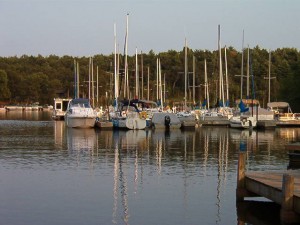
Barnum Bay Marina on Lake Petenwell
The presence of algae in lakes has been around for millions of years and on occasion creates discussion among those not familiar with the organism. As the state with more than 15,000 lakes knows, algae is a part of a lakes eco-system but protecting against an abundant growth is key to avoiding the potential blooms. Much more information about algae, what triggers algae blooms and when they occur, the differences between algae and blue-green algae, and what is being done to reduce algae blooms on Wisconsin Lakes can be found HERE.
The Culprit
Phosphorus has long been recognized as the controlling factor in plant and algae growth in Wisconsin lakes and streams. Phosphorus entering our lakes and streams comes from sources such as waste water treatment plants, paper mills, farm fields, residential lawns, urban streets and parking lots. First of its kind regulations along with initiatives by local citizen groups have recently lead to a reduction of phosphorus input into Lake Petenwell. Learn more about how phosphorus impacts our lakes and the growth of algae by clicking HERE.
New Phosphorus Regulations
Looking to protect their natural resources, the state of Wisconsin took action. In December 2010, Wisconsin became the first state in the country to adopt phosphorus water quality standards for lakes, reservoirs, rivers, and streams. Additional information related to this legislation, approval of the plan by the Environmental Protection Agency (EPA), implementation, and enforcement can be found at the following links.
Wisconsin’s Phosphorus Rule Approved by EPA
Milwaukee Journal Sentinel reports EPA approval of Wisconsin’s Phosphorus Rule

Beach at The Lure on Lake Petenwell
Wisconsin’s Phosphorus Rule, Implementation, More Information by WI. DNR
Local Initiatives
In addition to the statewide, first of its kind regulations that were enacted in 2010, more local initiatives have been launched on Lake Petenwell and Castle Rock Lake to help reduce the phosphorus levels and eliminate algae blooms.
- Reduction in phosphorus output by point and non-point sources located in the Wisconsin River watershed and ultimately feed into both lakes.
- 4 year monitoring program involving UW-Stevens Point, WI. DNR, and local volunteers to measure water clarity,temperature, phosphorus and nitrate levels.
- Succeeded in getting a new “drawdown” established for the lake designed to improve water quality and fish habitat by slowing the drawdown allowing aquatic plants to grow which will use incoming phosphorus.
- Succeeded in getting Domtar’s Rothschild paper manufacturing plant to meet its mandated phosphorus discharge limit.
- Installed 1,500 plants in Lake Petenwell known to compete with algae for vital nutrients
- Additional initiatives can be found HERE
While the reduction in phosphorus is a long term project, all the initiatives above have helped reduce the amount of phosphorus entering Lake Petenwell from point sources by more than 50%. Here is a link showing the year by year Annual Phosphorus Load Input (1999-2011).
Your Enjoyment
With algae being a mainstay in Wisconsin lakes, recreation of all sorts can still be enjoyed on Lake Petenwell even if algae is present. The lake covers 23,000 acres, 36 square miles, and is 14 miles long by 6 miles wide at the widest stretch. The practical matter of algae blooms is that they are typically blown by the wind and any wave action to the leeward side of the lake. Lake users can simply motor out to the middle or other side of the lake to enjoy the water on those rare days an algae bloom persists. Don’t just take our word for it. Read what other residential and business owners have to say about their experiences on the lake by clicking HERE.
Sources
Wisconsin DNR
Milwaukee Journal Sentinel
Star Journal Now
PACRS
CleanWisconsin.org


